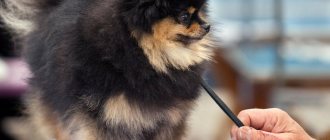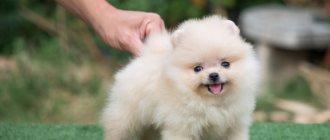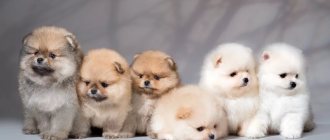In appearance, the orange resembles a cotton ball of wool on thin but strong legs and with an elongated muzzle.
He perfectly combines decorative appearance and impulsive temperament.
Of the Spitz dogs, this is the smallest dog, and if the FCI perceives the Pomeranian Spitz as a variety of the German Spitz in the Pomeranian type, then other cynological federations consider it as a separate breed.
Pomeranian Spitz
Description
The Pomeranian Spitz originated in Germany - Pomerania, where the name of its breed comes from.
It is the smallest variety among the Spitz, which is why for a long time America and Russia called this breed dwarfs or miniature Spitz.
Despite the fact that the Pomeranian is a decorative breed of dog, the pet has good ingenuity and intelligence, so it copes well with the training course.
Photos of dogs
Spitz dogs are distinguished by their miniature size and the unprecedented beauty of their coat - soft, cotton wool with a rich undercoat gives the dog an airy appearance.
No less attention is paid to the thick collar and fluffy tail, which has the habit of resting on the pet’s back.
The dog has medium-sized, dark eyes. The look is attentive, playful.
Due to its light weight, the Pomeranian moves easily and flexibly, and often breaks into a run.
Character
The Pomeranian has a rather impulsive temperament.
The dog is an ardent fan of movement, which is why he will never prefer calmness to active play. He will happily run around the yard and bark, inviting you to share his joy. The pet is also quick to adapt and will happily accompany its owner on trips.
The dog is suspicious of strangers and is unlikely to approach first; he would rather watch the stranger on the sly.
In relations with the owner, the dog often shows stubbornness, moreover, it may try to challenge the leadership in the house. The Spitz is far from a modest dog; it is difficult for her to refuse the opportunity to subjugate anyone.
When a new addition to the family occurs, a dog may even show dissatisfaction, so it is important to raise and train a puppy from childhood. Otherwise, the Pomeranian will be happy to be useful and will happily become a loyal friend for the family.
Similarities between German and Pomeranian
Dogs from the Spitz category have similarities in structure, which makes them very similar to each other. German Spitz and Pomeranian have the following general characteristics of their appearance:
- neat, smooth, elongated muzzle;
- erect ears with pointed ends;
- collar from withers to chest made of thick wool;
- thin graceful paws, smooth at the bottom;
- fluffy tail lying on the back.
German Spitz
The appearance of Pomeranians and Germans is decorative. The expression on the faces is joyful.
pomeranian spitz
German Spitz
Description
It is not for nothing that the German Spitz was classified as a companion dog; at one time the dog served man faithfully, which is why it was in demand among ordinary people for a long time as a watchman. This was even before aristocrats became interested in the breed.
The breed was valued for its loyalty and courage - the dog, despite its small size, bravely rushed to confront offenders and steadfastly endured long expeditions, following its owner.
In general, the German Spitz can boast of a rich history. This is an ancient dog, whose ancestors include many other different breeds.
Photos of dogs
The German Spitz represents a whole group of dogs, which includes large, medium and small Spitz.
However, differences in size do not prevent dogs from having a similar appearance, character and origin. Spitz dogs have the same compact build, thick hair, erect ears, elegant collar, pants and bushy tail.
Character
The German is famous for his balanced character. Long service and rich heritage tell. This is a loyal dog that is highly trainable.
Also, a dog can show itself well in the role of a watchman and notify its owners about strangers by barking. Spitz barks loudly and piercingly, but with proper upbringing, the pet will only give voice on command .
In general, this is an active and lively breed that will never refuse to play. But it will not impose itself if the owner is completely immersed in his own affairs.
Animals know when to stop and make concessions in many ways. Except for those cases when a stranger is walking around the house. Spitz dogs do not favor strangers. On the one hand, this gives dogs an advantage in their career as a guard, on the other hand, it gives them the stigma of being an unenviable neighbor or lodger.
Origin of the breed
Spitz dogs are one of the most popular breeds among breeders today. They have a variety of colors, sizes and appearances, which allows everyone to choose a favorite to their taste. At the same time, many factors indicate that the German and Pomeranian Spitz have the same exterior. Although there are significant differences in growth and other characteristics, by which it is quite easy to determine the subspecies. To understand the differences between the German and Pomeranian Spitz, it is necessary to understand the history of the origin of these breeds.
Pomeranian Spitz
The family tree of the Klanspitz goes back thousands of years and begins in the Stone Age. It is believed that they appeared naturally, and their ancestors were pile Spitz and turf dogs. Selection took place naturally under the influence of the environment, due to which only the strongest and most developed representatives of the species survived.
The ancient representatives of the German subspecies were much larger than the real ones. They were used by poor people to hunt wild animals and protect their territory.
Interesting ! Due to the fact that such pets began to be owned by individuals of royal blood in Germany, they became popular in the royal courts of the rest of Europe. It was this fact that served as the beginning of the work of breeders to breed small-sized dogs.
Germans were brought to England during the reign of Queen Victoria. Due to the fact that they were brought from Pomerania, they began to be called Pomeranians (Miniature Spitz dog).
So, what is the difference between a Pomeranian and a German Spitz? The breeders, having started work, bred miniature representatives of the breed, which to this day have a spectacular appearance and exquisite coat.
Several decades later, American scientists added some touches to the dwarf pets, and the difference became obvious; it is quite easy to distinguish the original representatives from the current ones.
Pomeranian and German Spitz differ in the following characteristics:
- origin story;
- body size;
- head shape;
- coat;
- coat color;
- number of teeth;
- tail shape;
- positioning of the front legs;
- breeding method.
German dog puppies
The American Club presents the difference in the standards of the German and Pomeranian Spitz as different breeds, when the RKF classifies the Pomeranian as a subspecies of the ordinary German.
What are the differences between the breeds?
Height and weight
| Indicators | Pomeranian Spitz | German Spitz |
| Weight | 2-4.5 kg. | Small (Kleinspitz) - 8-10 kg, medium (middlespitz) - 11 kg, large (grossspitz) - 13 kg, Wolfspitz - 20-28 kg. |
| Height at withers | 18-22 cm. | Small (Kleinspitz) - 22-28 cm, medium (Middlespitz) - 29-39 cm, large (Grossspitz) - 40-50 cm, Wolfspitz - 42-56 cm. |
NOTE!
Only the German Spitz is registered with the Fédération Cynologique Internationale (FCI), while the Pomeranian is no more than one of its varieties. The Pomeranian is recognized as a separate breed by clubs in Canada, England and America (American Kennel Club).
Body type
| Indicators | Pomeranian Spitz | German Spitz |
| Head | In the shape of a cylinder. The forehead is convex, the transition to the muzzle is well defined. The length of the muzzle is slightly shorter than the skull. The general appearance of the head resembles that of a bear. | Wedge shaped. The transition from forehead to muzzle is smooth. |
| Ears | Widely spaced. Small ones. | Closely spaced. With sharp ends. |
| Teeth | Incomplete teeth are acceptable. | Full composition (42). |
| Eyes | Not convex, oval in shape. Dark color. | Small, oval shaped. Dark color. |
| Neck | Short, wider at the shoulders. The fur falls off in the form of a mane. | Set on high. |
| Torso | Square format. | Square format. |
| Paws | Strong, with undercoat. | Small, thin, without undercoat. |
| Tail | Arc-shaped. | Has the habit of twisting into 1-2 rings. |
Simply put, if a dog looks like a little bear cub moving its well-fed legs, then it is an Pomeranian. They, as a rule, have a round muzzle and are slightly pressed down, while the German muzzle is elongated, like a fox. Among other things, the dog is distinguished by a lush mane and sophisticated paws.
Wool texture
The German has two types of hair: the outer coat (long, coarse, straight hair) and the undercoat (short, wavy hair). The animal's coat often puffs up in different directions, which is why the dog looks like a soft toy.
The coat color of the German Spitz is quite varied, but primarily depends on the variety.
The Pomeranian's undercoat is long and the hair tends to resemble a spiral. On the head, this is especially noticeable when the hair folds into the shape of a cap on top, and below it falls in the form of a mane. Pomeranians have weakly expressed guard hairs and the pet's feel can be easily compared to cotton wool.
Acceptable colors:
- black;
- black and tan;
- white;
- cream;
- sable;
- chocolate;
- zonal gray;
- orange.
Character
The Pomeranian has an active lifestyle and a desire to be anywhere and everywhere. These pets are not familiar with the blues; dogs will always find something to do with themselves. In short, Spitz dogs can be characterized as follows: plays, eats, plays, sleeps. And again.
The German is calmer and more balanced. He, of course, will not ignore the game, but if the owner is busy, then the German Spitz will not annoy him and will patiently wait.
Unlike the Pomeranian, who is driven by energy, the German is driven by alertness. These dogs still play the role of a companion for their owners, and therefore it is natural for them to play the role of protector and support for the family.
Expert opinion
Kozhevin Semyon Kirillovich
Expert dog handler.
The main feature by which these breeds can be distinguished is their dimensions. In relation to the German, the height fluctuates between 18 and 55 cm, while the height of the Pomeranian will not exceed 22 cm. This difference is due to the formation of breeds, while life did not spare the Germans, forcing dogs to adapt to survival in the wild and serve ordinary people, the Pomeranians skipped the adaptation process due to its inexpediency. This is an exclusively decorative breed.
History of the breed
The main variety, the German Spitz breed, arose naturally, having formed in nature under certain climatic conditions. These dogs were influenced only by natural evolutionary factors. They were not initially subjected to artificial selection by humans in order to obtain animals of a certain appearance. Thus, only strong individuals that were not susceptible to disease and adapted to the climate of their habitat were selected through natural means. They are distinguished by their large size and very balanced character.
Image by John-Meyer - pictures from Pixabay
The Pomeranian was created artificially, like most dwarf dog breeds. The similar origin of the dwarf size breed is the main difference. The Miniature Spitz was bred artificially for a long time by breeders who set themselves the task of obtaining a miniature dog with an abundance of hair, intended exclusively for decorative keeping.
To reduce their size, the German Spitz was crossed with a number of miniature breeds. Long-term work initially led to the appearance of a Pomeranian with a standard height of 20-22 cm at the withers. Recently, the dog was able to be reduced even more - its height at the withers is less than 20 cm - but this seriously undermined its health, since extreme miniature damages the condition of the internal organs and makes the skeleton excessively fragile.
These tiny dogs are the top dwarf dog breeds. The first mention of oranges appeared in the 19th century. As a dog breed registered in the USA. In other countries, Pomeranians are considered to be a variation of the German breed.
What are the similarities?
If the German Spitz is an officially recognized breed, then the situation with the Pomeranian is somewhat different. Many cynological federations still do not consider this dog as a separate breed, which is why it is one of the varieties of the German Spitz.
As a result, dogs have many common features, be it external characteristics or character.
This is not surprising if a German laid the foundation for the formation of the Pomeranian breed. In an attempt to start a smaller version of it, it happened to breeds that were noticeably smaller in size. This is why the external characteristics of animals coincide so much.
Spitz equally love various games and are gifted with unprecedented resourcefulness, which helps dogs not only solve various dog puzzles, but also skillfully influence their owner in order to get what they want. Still, Spitz are not harmless sheep and will happily take on new heights of the hierarchy.
Both dogs are cold and unapproachable towards strangers. They won’t show aggression, but they won’t happily wag their tail when they see a stranger.
They are much more interested in their household. Animals favor both adults and children. With the latter, you can not only join the game, but also have a little fun.
Why does the price vary?
The Pomeranian Spitz is not a rare breed in our country, but one of the most common. But despite this, a number of factors influence how much a Pomeranian Spitz costs, these are:
- his ancestry; the purpose for which it is purchased; region of purchase; the puppy's prospects.
If you simply buy a Pomeranian as a pet, then it will cost you much less than if you plan to participate in exhibitions with it. The most expensive Spitz dogs are those that fully match the breed characteristics and are in excellent health. These are future breeding sires and potential breed champions.
Who is more picky about feeding?
Both Spitz are fairly unpretentious animals and, as is typical of many small breeds, have a good metabolism. Therefore, it is not surprising that dogs have a large appetite, which often becomes the cause of obesity.
At the same time, Spitz dogs have a strong need for vitamins and microelements. If the pet does not receive the daily dose of necessary nutrients, this will greatly affect not only the appearance of the pet, but also the functioning of the internal organs.
Pomeranians, like Germans, rarely turn their nose up at a bowl of food . They are not disgusted by the monotony of dishes, but this does not mean that their owners cannot instill in them the same pickiness.
IMPORTANT!
Light-colored Spitz dogs are often susceptible to allergic reactions, so the owner should avoid a number of strong allergens, such as wheat and chicken.
Comparison of breeds by other criteria
Table of differences between a German Spitz and a Pomeranian on a five-point scale.
| Indicators | German Spitz | Pomeranian Spitz |
| Health | 4 | 3,5 |
| Abundance of shedding | 5 | 4 |
| Attachment to family, home | 5 | 4 |
| Attitude towards strangers | 2 | 3 |
| Attitude towards children and other animals | 5 | 4,5 |
| Guard qualities | 4 | 2,5 |
| Dog bodyguard | 4 | 2,5 |
| Activity | 4 | 3,5 |
| Training issues | 4 | 4,5 |
| Price | From 20 thousand rubles. up to 45 thousand rubles. | From 15 thousand rubles. up to 120 thousand rubles. |
Spitz dogs vary greatly in cost. On the one hand, this is due to the low fertility of the breeds, on the other, Pomeranians from the very beginning positioned themselves as an ornamental breed, so it is not surprising that its price is obviously higher than the cost of its relatives.
Difference in placement
A mandatory distinguishing feature of animals is the location of the metacarpus of the front paws relative to the ground. The Miniature Spitz must have paws perpendicular to the ground, otherwise the dog is discarded and cannot be used for breeding. For Germans, there will be a deviation from the norm if the pasterns are not at an angle of 20° to the ground.
Tail set
The tail of both types of dogs lies on the back. In the natural form of dogs, it is twisted into one, and sometimes two rings, which are located above the back. Decorative pets have a straight tail covering their back. No twisting is observed.
Wool
The differences in coat are due to the fact that the dog's natural shape has been adapted to living outdoors and withstanding adverse weather conditions. The coat is dense. The guard hair is abundant, adjacent to the body, and is of considerable length. He is direct and rough. Under the top layer there is an abundant undercoat of dense, soft, slightly curly hairs.
The decorative dog has almost no guard hairs (the hair is straight), and the coat consists of a long undercoat, the hairs of which curl. Pomeranian fur requires constant care. Frequent bathing is necessary to get rid of dust. The color of the coat is varied, from black and black and tan to white.
To whom and who will suit?
The German Spitz has an easy-going character. This is a very balanced animal with unprecedented wariness towards everything alien and incomprehensible.
Hereditary qualities are felt, encouraging one to preserve and protect the family. The aboriginal way of life has instilled many traits: over the long history of the breed’s formation, the dog has become accustomed not only to being close to its owner, but also to vigilantly observing its surroundings. Therefore, the German will become a desirable pet and a wonderful friend for both elderly people and people with disabilities.
The Pomeranian loves movement, and he would be happy with owners who share his passion.
This is an active and cheerful breed that finds it difficult to sit in one place, so the pet will easily take root in families with children and other pets, largely thanks to the ability to find a common language with anyone.
However, this does not apply to very young children who have not yet learned to distinguish between what is and is not possible. The Pomeranian cannot boast of its size, and playing with children can often cause accidents.
Spitz dogs are convenient for people living in apartments, both large and small. Fortunately, pets are unpretentious and do not take up much space.
NOTE!
Another thing is issues of education. German and Pomeranian Spitz require a lot of attention. Their owner must be able to find the time and desire to instill in the pet the basics of training, otherwise the pet’s behavior will become a problem in the future.
Origin of rocks
The German Spitz or German Spitz is one of the oldest breeds in Europe. The ancestors of these animals - peat dogs - lived back in the Paleolithic era. Over the centuries, they formed naturally without human intervention. Only the strongest individuals survived, so representatives of the breed acquired excellent health.
Initially, animals guarded the houses of the German poor. Larger individuals were used for hunting and used as shepherds. As a result, the breed was divided into several species - the pets had differences in size and some external features. A little later, the local aristocracy liked the animals and gradually they became popular in secular circles. After this, breeders began targeted selection.
Work on breeding oranges was carried out in the second half of the 19th century. They were crossed with other miniature dogs - the emphasis was on the decorative qualities of the animals. Then the pets came to America, where local breeders registered them as a new breed.
Now the American, English and Canadian Kennel Clubs believe that the differences between the German and Pomeranian Spitz allow these dogs to be divided into 2 breeds. But according to the FCI classification and the RKF, which is part of it, the Pomeranian Spitz is considered a subspecies of the German Spitz.











